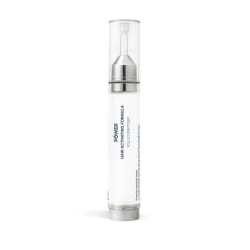Hair Loss
Explaining hair loss in simple terms is quite difficult. There are also many opinions on the subject. According to the latest findings, the reason for male hair loss is that DHT (dihydrotestosterone), formed when testosterone and the enzyme called 5–alpha reductase meet, binds onto receptors in the hair root. The body interprets this as something going wrong and the immune defences kick in. The immune system attacks the hair follicle and at first the hair develops a shorter growing phase. Later on, your hair thins. Later still, some people lose all their hair. Others find that they stop losing hair and they retain their thinner head of hair for many years.

Summary
-
-
Why do we lose hair?
-
Solutions: hair transplantation, medical treatments, and cosmetic alternatives to conceal hair loss.
- Future hope – new preparations such as Follicopeptide® show promising results without known side effects.
-
Hair loss is a problem for many, and there are several different factors behind why we lose hair. The process may seem simple to document yourself in front of the mirror, but we naturally recommend consulting a doctor for closer examination. If you want to take countermeasures, it is important to start as early as possible.
CAUSES OF HAIR LOSS
-
Deficiency of certain minerals or vitamins. A lack of iron, vitamin B12, or folic acid can cause increased hair loss.
-
Increased levels of the male hormone dihydrotestosterone (DHT). DHT is a by-product of the sex hormone testosterone that can attack the hair follicles and cause them to shrink.
-
Alopecia areata, patchy hair loss. Caused by emotional stress or infection, mainly affecting ages 20–50.
-
Aging. The older you get, the fewer active hair follicles you may have. This in turn leads to thinner hair.
-
Genetic factors. Hereditary hair loss affects many and can begin in men as early as their late teens.
If you want to do something more permanent about the problem, there are indeed solutions for those who are ready to invest some energy (and money). The solutions can be divided into three groups: hair transplantation, treatment with preparations, and cosmetically concealing hair loss.
HAIR TRANSPLANTATION
Hair transplants can be done in several different ways and are most often performed on people with advanced hair loss. The most common method of transplanting hair is through so-called micrografting, i.e. hair is taken from the neck and implanted into the bald area strand by strand. With this method, a natural result is achieved, and it can be very difficult to see that the hair has been transplanted.
However, the transplantation can in some cases have side effects (such as scarring) and is also not successful in all patients. In addition, it is an expensive solution, making it not an option open to everyone.
Tip: Before undergoing transplantation, carefully check your surgeon’s reputation. Ask for references from previous patients who have undergone similar procedures.
How much does a hair transplant cost?
The price depends on how many follicular units are transplanted (number of "grafts"), which technique is used, and the clinic’s experience and reputation:
-
Price: Usually between 30,000 – 100,000 SEK, depending on the scope of the treatment and technique.
-
Small procedures: from approx. 30,000 SEK
-
Medium procedures (about 1,000–2,000 grafts): approx. 40,000–60,000 SEK
-
Large procedures/“premium methods”: up to 100,000 SEK
MEDICATIONS FOR HAIR LOSS
Which remedy is most effective against hair loss
if you don’t want surgery?
-
Minoxidil (over-the-counter topical solution)
Stimulates the hair follicles and helps to slow down hair loss while promoting slight regrowth – for both men and women. It is the most well-documented OTC remedy and can be found, for example, in the product Rogaine. Hair is maintained as long as treatment continues, but once stopped, hair loss usually resumes quite quickly. Treatment gives the best results in men who have not been losing hair for more than five years. -
Finasteride (prescription tablet, for men)
Lowers DHT levels and effectively slows hair loss. In 86% of men taking Propecia, hair loss stops, and in 48% there is significant regrowth. However, the active substance in Propecia has been shown to reduce sexual desire in about four percent of men, so the risk of side effects should be weighed against the effect.
NOTE! Combining minoxidil and finasteride (since they act in different ways) is considered to give better results than using only one of them.
-
Products (shampoos, tablets) containing natural preparations such as Cynatine HNS (Keratin), oleanolic acid, and Biotinyl-GHK as well as Saw Palmetto (natural finasteride). Here we can mention popular Powers hair shampoo and conditioner as well as Nisim’s products.
-
New research underway. Newly developed drugs based on stem cell technology, such as PP405, have the potential to activate dormant hair follicles and actually bring them back to life – and thereby enable new hair growth. However, studies are still at an early stage. Another new revolutionary solution is preparations based on Follicopeptide® (see below), which have no documented side effects.
FOLLICOPEPTIDE®
–- THE HOPE FOR THE FUTURE
Follicopeptide® is a new skin-friendly peptide developed in Sweden that in studies has shown equal or better results than Minoxidil and Finasteride but without side effects. It is a fast and effective working preparation that was originally injectable, but now developed into a simple and manageable daily gel for self-use.
During a study at Lund University on arteriosclerosis (narrowing of the arteries), researchers discovered that osteopontin - a protein naturally found in the body - stimulated hair growth. This led to the creation of the now patented formula, which has been shown in clinical studies to increase the number and thickness of hairs in the treated area. Follicopeptide® works through a different mechanism than currently available preparations and, unlike many medical preparations in tablet form, has so far no reported serious side effects, making it a promising future option for both men and women.
Follicopeptide® can be found in Powers Follicopeptide® Solution - Hair Activation Formula. Safe and easy to use!
CONCEALING HAIR LOSS
Many people affected by hair loss feel they want to do something about the problem immediately in the form of a cosmetic touch-up. One increasingly popular option is so-called "hair pieces," i.e. toupees – a product that has become more advanced and provides a natural result as well as great flexibility. However, it is expensive and requires both time and maintenance and is not always easy to handle without professional help.
Hair fibers
Hair fibers are an affordable, effective alternative for those with minor hair loss or thinning hair, often containing keratin or cotton fibers. At Gents, Power Fibers are available in different colors. Power Fibers help people with thinning hair to conceal their hair loss by sprinkling or blowing hair fibers into their existing hair. The fibers build up the existing hair and make it up to 4 times thicker.
Power Fibers are used every day or only on the days you want thicker hair, e.g. when going to a party. They remain in the hair in both rain and wind and can easily be washed out with ordinary shampoo.
We wish you the best of luck!



